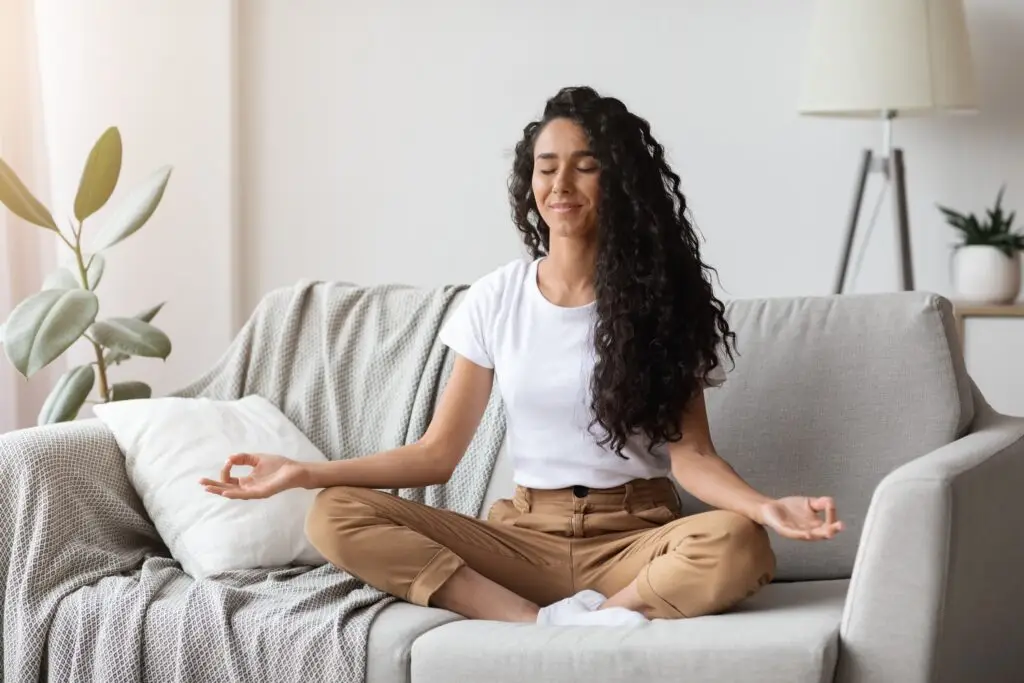Feeling overwhelmed with anxiety, depression, or the modern demands of daily life?
Are you searching for relief from the stress that’s been weighing on your shoulders for work and home life?
Learning how to practice mindfulness may be the key to easing your symptoms of stress, anxiety, or depression.
But what is mindfulness? Where do you start? What if you do it wrong? And will it make a difference?
Take a deep breath. The fact that you’re here reading this means you’re ready for a change. Mindfulness is a powerful tool to help you feel more grounded, reduce stress, and improve your mental health.
This article will cover what is mindfulness, the different types, how to start a basic mindfulness routine, how to use meditation in your mindfulness practice, and much more.
What is mindfulness?
Mindfulness is a state of active, open attention to the present moment. It’s about fully engaging in what you’re doing and where you are without being overly reactive or overwhelmed by what’s happening around you.
When you practice mindfulness, you’re learning to observe your thoughts and feelings without judgment. This skill is simple and can be life-changing with consistent use.
Research has shown that mindfulness practices can significantly reduce symptoms of anxiety, depression, and stress, making it a valuable tool in online therapy.
Mindfulness is more than just stress reduction
While mindfulness is often associated with reducing stress, its benefits go far beyond that.
When you practice mindfulness, you’re training your brain to focus better, become more aware of your thoughts and emotions, and respond to situations more clearly and calmly.
It’s about cultivating a deeper understanding of yourself and the world around you. This practice can help you feel more balanced, even while facing life’s challenges.
Also, mindfulness can be a powerful complement to online therapy approaches such as Cognitive Behavioral Therapy (CBT) or Dialectical Behavior Therapy (DBT), which is a therapy that can help manage emotions and thoughts. Integrating mindfulness with these therapies enhances emotional regulation and mental clarity, providing a well-rounded approach to mental health.
The different types of mindfulness
There are many ways to practice mindfulness, and finding the type that resonates most with you is essential. Here are some of the most common types of mindfulness:
- Breath awareness: This involves focusing your attention on your breath and noticing the sensation of the air entering and leaving your body. It’s a simple yet powerful way to anchor yourself in the present moment.
- Body scan: In this practice, you systematically bring attention to different parts of your body, noticing any sensations, tension, or areas of relaxation. It’s a great way to connect with your physical self and release stress.
- Mindful walking: This practice involves walking slowly and deliberately, paying close attention to the sensations in your feet and legs as they touch the ground. It’s a wonderful way to integrate mindfulness into daily activities.
- Loving-kindness meditation: This involves focusing on sending thoughts of love and kindness to yourself and others. It’s a powerful way to cultivate compassion and positive emotions.
- Mindful eating: This practice encourages you to slow down and fully experience your food’s taste, texture, and aroma. It’s a great way to bring mindfulness into your everyday life and improve your relationship with food.
If you are new to meditation, working with a mental health professional trained in mindfulness-based interventions can help ensure proper guidance and enhance the benefits of these practices.

The basics of mindfulness practice
Starting a mindfulness practice can be as simple as you need it to be. Here’s a simple guide to help you get started:
- Choose a time and place: Set a specific day to practice mindfulness. It could be in the morning before you start your day or in the evening before bed. Find a quiet place where you won’t be disturbed.
- Start small: Begin with a few minutes of mindfulness practice daily. As you become more comfortable, you can gradually increase the time.
- Focus on your breath: One of the simplest ways to practice mindfulness is to focus on your breath. Notice the sensation of the air entering and leaving your body. If your mind wanders, gently bring your attention back to your breath.
- Be kind to yourself: It’s normal for your mind to wander during mindfulness practice. When it happens, notice where your mind went and gently bring your attention back to the present moment. Remember, you may still have wandering thoughts. Be sure to observe them without getting caught up in them.
- Practice regularly: The key to reaping the benefits of mindfulness is consistency. Try to practice mindfulness every day, even if it’s just for a few minutes.
Types of meditation to practice mindfulness
Meditation is a practice where you train your attention and awareness using a specific technique. It’s a central component of mindfulness practices and has been used for thousands of years across different cultures for spiritual, emotional, and physical wellness.
Meditation is a versatile practice with many forms, each offering unique benefits. While mindfulness meditation is highlighted in this article, you may enjoy other types of Meditation equally. Here are some of the most popular forms of Meditation that you can use as you build your practice:
1. Mindfulness meditation
Overview:
Mindfulness meditation involves paying attention to your thoughts as they pass through your mind. You don’t judge or become engaged with thoughts; instead, you observe and note any patterns. This practice combines concentration with awareness.
How it works:
You typically sit quietly, focus on breathing, and bring your attention to the present moment. When thoughts, emotions, or sensations arise, you acknowledge them and gently bring your focus back to your breath or the present moment.
Benefits of mindfulness meditation:
Mindfulness meditation helps increase your awareness of your mental and emotional patterns, which can reduce stress, anxiety, and depression. It enhances your ability to stay present and improves your overall emotional regulation.
2. Loving-kindness meditation (metta meditation)
Overview:
Loving-kindness meditation is a practice of directing positive energy and well-wishes toward yourself and others. This form of meditation is about cultivating an attitude of love, compassion, and goodwill.
How it works:
You begin by focusing on yourself, repeating statements such as “May I be happy,” “May I be healthy,” or “May I be at peace.” Gradually, you extend these wishes to others, including loved ones, acquaintances, and even those with whom you have conflict. The practice usually ends by extending these wishes to all beings everywhere.
Benefits of loving-kindness meditation:
Loving-kindness meditation fosters compassion, empathy, and positive emotions. It can help reduce feelings of anger and resentment, promote emotional resilience, and improve relationships.

3. Body scan meditation
Overview:
Body scan meditation involves paying attention to your body’s physical sensations, often systematically from head to toe. It’s a powerful tool for developing a deeper connection with your body and releasing physical tension.
How it works:
You typically start at the top of your head and gradually move your attention down through your body, noticing any areas of tension, discomfort, or relaxation. The focus is on observing sensations without judgment, simply noticing what’s present.
Benefits of body scan meditation:
Body scan meditation is particularly effective for reducing physical stress and tension. It increases bodily awareness, which can help with pain management and improve the mind-body connection.
4. Guided meditation
Overview:
Guided meditation is a form of meditation where a guide or teacher leads you through the process, often using imagery, visualization, or specific instructions to help you relax and focus.
How it works:
You listen to the guide and follow the instructions. This might involve visualizing a peaceful place, focusing on your breath, or working through a series of mental exercises designed to promote relaxation and mindfulness.
Benefits of guided meditation:
Guided Meditation is excellent for beginners as it provides structure and direction. It can be used for relaxation, stress reduction, and enhancing focus. It’s also practical for exploring gratitude, self-love, and healing themes.
5. Movement meditation
Overview:
Movement meditation involves being mindful while in motion, such as walking, yoga, tai chi, or other gentle, flowing movements. It’s a great way to practice mindfulness for those who find it challenging to sit still.
How it works:
In movement meditation, you focus on the sensations and movements of your body. For example, in mindful walking, you pay attention to each step, the feel of your feet on the ground, and the rhythm of your breath.
Benefits of movement meditation:
Movement meditation helps you connect with your body, improve physical awareness, and integrate mindfulness into daily activities. It’s especially beneficial for those who prefer a more active form of Meditation.

6. Visualization meditation
Overview:
Visualization meditation involves focusing on a specific image, scene, or object in your mind’s eye. This type of Meditation uses the power of your imagination to bring about a state of calm, focus, and mental clarity.
How it works:
You might visualize a peaceful scene, such as a beach or a forest, and immerse yourself fully in the experience, imagining the sights, sounds, and feelings associated with it. Visualization can also involve focusing on specific goals or intentions.
Benefits of visualization meditation:
Visualization meditation can enhance focus, reduce stress, and help manifest positive outcomes by aligning your mind with your goals. It’s a powerful tool for relaxation and mental rehearsal.
Mindful practices for everyday
You don’t need to set aside large chunks of time or start with an overwhelming list of exercises to begin practicing mindfulness.
Here are some simple ways to incorporate mindfulness into your daily life:
- Mindful eating: Take a few moments to taste and enjoy your food. Notice the flavors, textures, and smells with each bite.
- Mindful walking: As you walk, pay attention to the sensation of your feet touching the ground and the rhythm of your steps.
- Mindful listening: When someone is speaking to you, really listen. Pay attention to their words, tone, and body language.
- Mindful breathing: Take a few deep breaths whenever you feel stressed or overwhelmed. Focus on the sensation of the air moving in and out of your lungs.
Five common mindfulness meditation questions
1. Do I need special equipment to practice mindfulness?
You don’t need any special equipment to practice mindfulness. All you need is a quiet space and a few minutes. As you advance in your practice, you may invest in a meditation cushion or a comfortable chair if you need more comfortable support while you practice.
2. How long should I practice mindfulness each day?
Start with just a few minutes each day and gradually increase the time as you become more comfortable. Even 5 to 10 minutes a day can have significant benefits.
3. What if I can’t clear my mind?
It’s entirely normal for your mind to wander during mindfulness practice. The goal is to observe your thoughts without getting caught up in them. When your mind wanders, notice it and gently bring your attention back to your breath.
4. Can mindfulness help with anxiety and depression?
Yes, mindfulness has been shown to be effective in reducing symptoms of anxiety and depression. By practicing mindfulness, you can learn to manage your thoughts and emotions more effectively, leading to greater emotional resilience and mental clarity.
5. How can I stay motivated to practice mindfulness regularly?
Consistency is critical to reaping the benefits of mindfulness. Try to integrate mindfulness into your daily routine, even just for a few minutes. Remember that mindfulness is a journey, and it’s okay to start small and build your practice over time.
Get support while on your mindfulness journey
Starting a mindfulness practice can be a powerful step toward improving your mental health. It’s also normal to need support along the way. If you’re struggling with symptoms of anxiety, depression, or stress, or if you’re looking for guidance in building your mindfulness practice, online therapy with Makin Wellness can help.
Our experienced therapists can provide personalized support to help you identify your mental health goals, navigate your mental health challenges, and develop a mindfulness routine that works for you. Whether you’re just starting out or looking to deepen your practice, Makin Wellness is here to support you.
Take the first step today by calling us at (833)-274-heal or scheduling a session with a specialized Makin Wellness online therapist and discover how mindfulness and professional support can transform your mental health.








